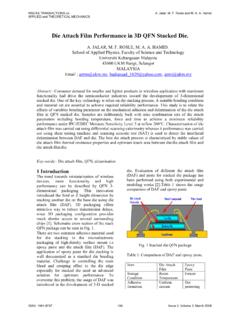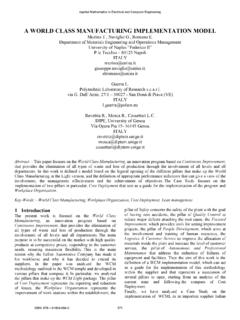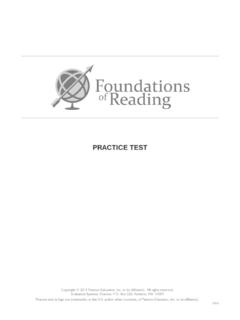Transcription of Teaching Implications of Information Processing Theory …
1 Teaching Implications of Information Processing Theory and Evaluation Approach of learning Strategies using LVQ Neural Network 1 ANDREAS G. KANDARAKIS and 2 MARIOS S. POULOS 1 Department of Special Education and Psychology University of Athens Greece 2 Department of Archives and Library Sciences Ionian University, Corfu, Greece Abstract: - In terms of Information Processing model, learning represents the process of gathering Information , and organizing it into mental schemata. Information - Processing Theory has definite educational Implications for students with learning and behavior problems.
2 Teachers with a greater understanding of the Theory and how it is formed to, select learning strategies in order to improve the retention and retrieval of learning. But it must also be taken into consideration that the learning environment has specific effects on academic achievement. Socialization alters the levels of stress, confidence, and even the content knowledge. Social support provides encouragement, stress reduction, feedback, and communication factors which enable learning. Furthermore, an evaluation of 4 learning strategies attempted via a well-formed LVQ Neural Network.
3 Key-Words: - Information Processing , memory, matacognition, learning strategies, general education classroom, learning, behavioral problems and neural networks. 1. Introduction While behaviorists talk about learning as the result of the interactions between an organism and its environment or changes in responses, the cognitive approach focuses on the knowledge which guides those responses. Cognitive learning Theory focuses on what happens in the mind, and views learning as changes in the learner s cognitive structure.
4 The rapid proliferation of computers has encouraged the use of computer model to explain learning. Information - Processing Theory , one of the dominant cognitive theories since 1970, attempts to describe how sensory input is perceived, transformed, reduced, elaborated, stored, retrieved and used. In terms of Information Processing model, learning represents the process of gathering Information , and organizing it into mental schemata (organized structures of stereotypic knowledge).
5 Learning is defined as the process of acquiring new Information ; while memory is defined as the persistence of learning that can be assessed at a later time. 2. The Information - Processing Theory At a first glance, the gathering and storage of Information may seem less efficient as a learning system compared to the behaviorist notion of associations between stimuli and responses. But learning through Information gathering has an advantage: flexibility. For example, if your route to home is represented by a mental map of the city, not fixed series of responses, you can take an alternative route when traffic is bad.
6 This is an effective behavior and depends on remembering Information at the right time. The Information Processing approach has led to a model of memory which is based on a computer analogy. By the late 1960s Atkinson and Shiffrin [1] proposed the most influential model of memory (see figure 1). It was assumed that Information came in from the environment, was processed by a series of temporary sensory memory systems (a part of the process of perception), and then fed into a WSEAS TRANSACTIONS onADVANCES in ENGINEERING EDUCATION Andreas G.
7 Kandarakis and Marios S. PoulosISSN: 1790-1979111 Issue 3, Volume 5, March 2008 limited capacity short-term store. This was assumed to act as a working memory. That is, a system for holding Information and allowing it to be used to perform a wide range of cognitive tasks, including transfer into and retrieval from long-term memory. Sensory memoryShort-term memoryLong-term memoryattentionrehearsalDecay(loss of Information with the passageOf time)Displacement(forgetting due to newIncoming Information )Interference(prior experiences make Learning and recall of Subsequent experiencesDifficult)FIGURE 1 The model of memory which proposed by Atkinson and Shiffrin (1968) Fig.
8 1: The model of memory proposed by Atkinson and Shiffrin (1968). According to this model, Information is processed in a sequence of steps. Memory is regarded as having three separate stages: sensory memory, short-term memory and long term-memory. The first of the three categories of memory, the sensory memory (visual and verbal), has a high capacity of Information , but a very short life of just a few milliseconds. The Information quickly fades unless we actively attend to it and perceive it. Since we are bombarded by sensory stimuli, we must selectively focus on those elements which are likely to be most significant.
9 This selection occurs through the process of attention. Attention is important because it selects the Information which becomes available to memory. We cannot make material meaningful, organize it, associate it, or visualize it if we do not get it in the first place. Unlike sensory memory that has short duration and high capacity, short-term memory (STM), has a longer duration and a limited capacity (5-9 meaningful items or chunks, see figure 2) based on continual rehearsal (manipulating the stimulus Information in order to code the Information for long-term memory).
10 STM can be thought of as activated memory (working memory), necessary for feeding Information into and out of the long-term memory. Fig. 2: A test of short-term memory. To test your short-memory, follow the instructions in the box. The last part of the model is the long-term memory (LTM). The term LTM is reserved for memory of experiences and knowledge that occurred at some point in time prior to the immediate past or near present. In a computer, LTM would be analogous to a storage device such as a hard disc.












